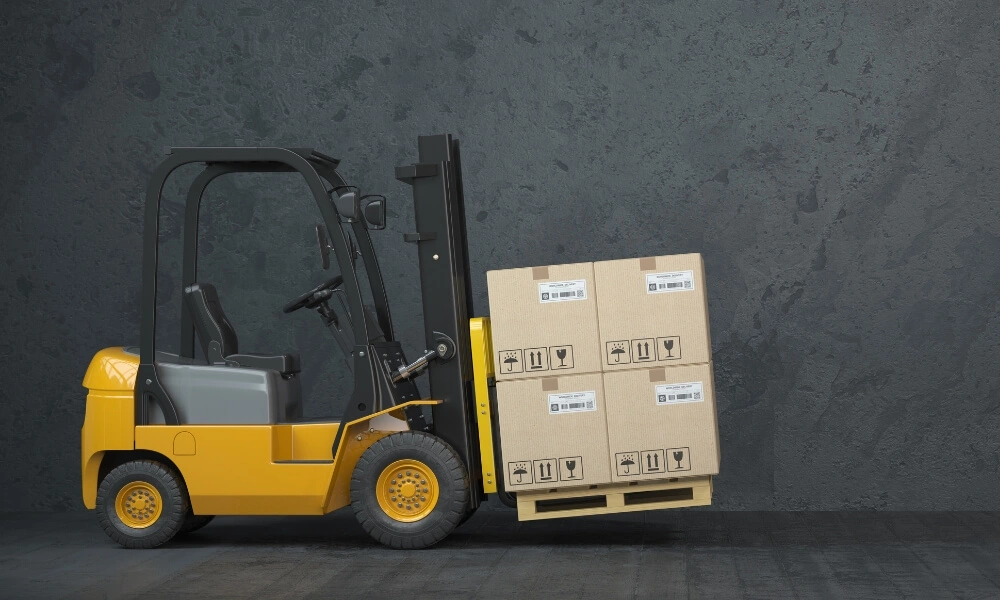Choosing the right forklift is essential for improving productivity, safety, and workflow efficiency. With many forklift types available—each built for specific tasks, environments, and load requirements—it’s important for warehouse managers, equipment buyers, and business owners to understand how each machine works and where it performs best. This comprehensive guide breaks down the most common forklift types, including standard models, narrow-aisle designs, rough-terrain machines, and heavy-duty industrial options.
Common Forklift Types
Before diving into details, here’s a quick overview of popular forklift types and their primary uses:
- Counterbalance Forklifts (Warehouse Forklifts): The classic forklift with front forks and a rear counterweight; ideal for most general indoor lifting tasks and pallet transport. Typically handles around 5,000 lbs loads.
- Reach Trucks: Narrow-aisle electric forklifts with extendable forks for high shelving; excellent for tight warehouse spaces and high stacking, but not suited for rough terrain.
- Order Pickers: Specialized forklifts that lift operators to pick individual items from racks (up to ~32 feet high); used in fulfillment centers and warehouses for piece-picking orders.
- Side Loader Forklifts: Forklifts where the operator’s compartment and forks are mounted sideways; designed to handle long, bulky materials (like lumber or pipes) in narrow aisles.
- Pallet Jacks (Manual/Electric): Small hand-operated or electric-powered pallet trucks for moving pallets at ground level; very compact and cost-effective, but limited lift height and capacity.
- Walkie Stackers: Walk-behind straddle lifts that can raise pallets higher than pallet jacks; low speed and power, but useful for stacking in tight areas where a full forklift isn’t necessary.
- Telehandlers (Telescopic Handlers): Rough-terrain lift trucks with a telescoping boom arm; cross between a forklift and crane, capable of forward reach and high lift (e.g. ~5,500 lbs up to 19 ft) – great for construction and agriculture.
- Rough Terrain Forklifts: Sturdy forklifts with large pneumatic tires and powerful engines for uneven outdoor surfaces; used on construction sites, yards, and farms, handling heavy loads (common capacities 6,000–8,000 lbs).
- Heavy-Duty (Industrial) Forklifts: High-capacity forklifts for heavy industrial or port operations; can lift extremely large loads (30,000 lbs and up), though with less maneuverability in tight spaces.
Below, we explore each of these forklift types in detail, including their features, typical applications, advantages, and limitations.
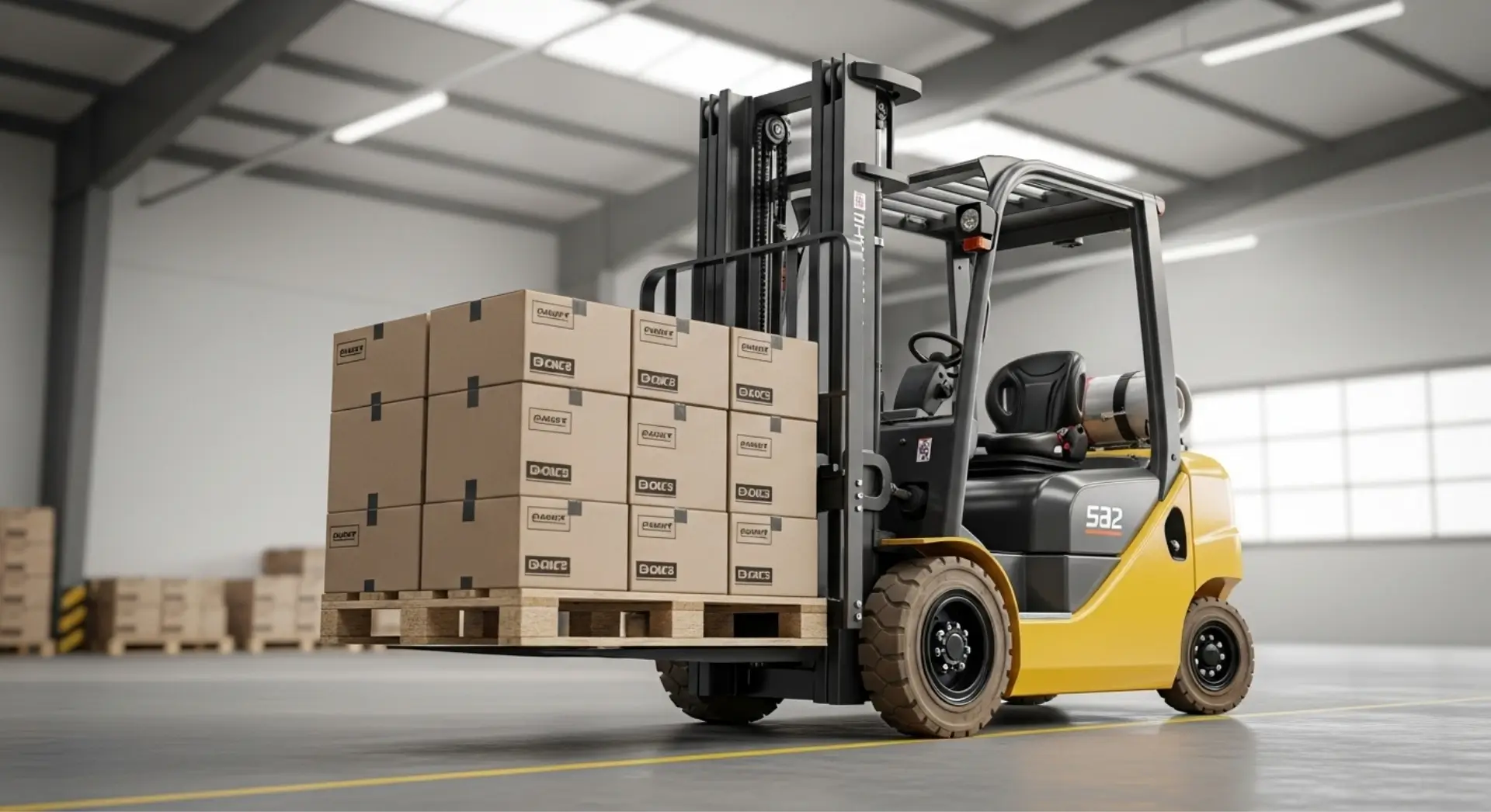
Counterbalance Forklifts (Standard Warehouse Forklifts)
Counterbalance forklifts are the most widely used forklift type in material-handling environments. They feature front-mounted forks and a heavy rear counterweight that balances the load, allowing the operator to drive straight up to pallets, containers, or materials without the need for additional arms or stabilizers. This simple yet powerful design makes them ideal for everyday lifting, transporting, and loading tasks across many industries.
Key Features
Counterbalance forklifts include several important design and performance characteristics that make them reliable and easy to operate in a wide range of environments.
- Three-wheel models offer tighter turning capability, making them suitable for confined indoor areas.
- Four-wheel models provide enhanced stability, especially when handling heavier or bulkier loads.
- Operator options include seated and stand-up units, supporting different workflows and frequent entry/exit needs.
- Lifting capacities typically range between 3,000–6,000 lbs, with many standard units built around a 5,000 lb capacity.
- Direct front-loading design enables the forklift to approach loads without outriggers or extended reach mechanisms.
Common Uses
Counterbalance forklifts are essential in both small and large operations due to their flexibility and ability to handle a wide range of materials.
- Ideal for loading and unloading pallets from trucks, docks, or staging areas.
- Frequently used to relocate materials within warehouses, manufacturing floors, and distribution centers.
- Effective for stacking pallets on ground-level or lower-tier racking systems.
- Suitable for outdoor use on smooth, paved surfaces such as loading bays or container yards.
- Versatile enough to serve in industries including retail, logistics, food and beverage, automotive, and general manufacturing.
Power Options
Counterbalance forklifts support multiple fuel and power systems, each suited to different work environments and performance needs.
- Electric (battery-powered) models offer zero emissions, low operating noise, and lower long-term maintenance, making them ideal for indoor and environmentally controlled facilities.
- Internal Combustion Engine (ICE) versions — using propane, diesel, or gasoline — provide greater torque and power for heavy-duty lifting or outdoor applications.
- The power choice depends on factors such as load requirements, operational run time, air quality standards, and access to fueling or charging infrastructure.
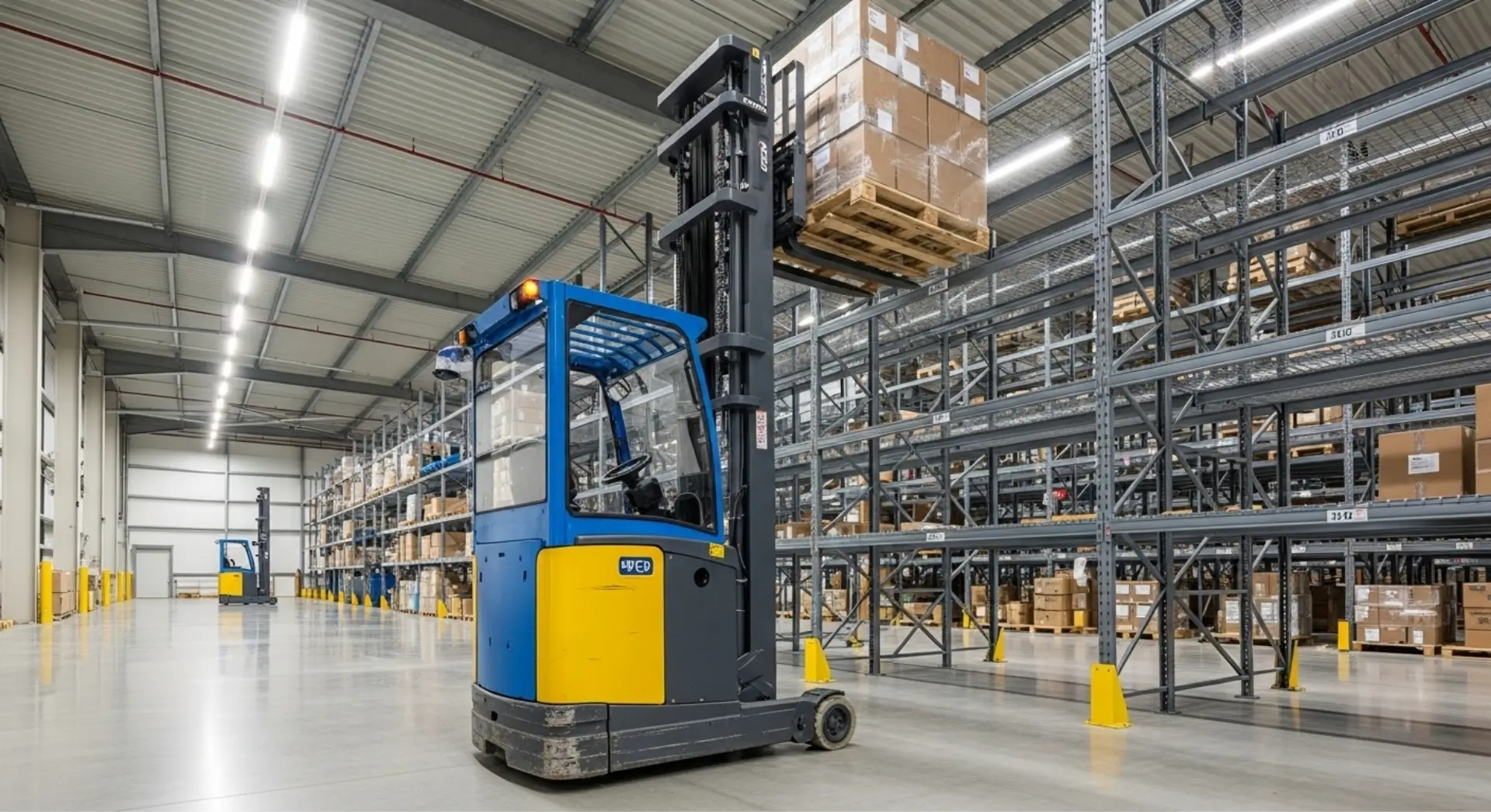
Reach Trucks (Narrow Aisle Forklifts)
Reach trucks are specialized forklifts designed for warehouses that need to maximize vertical storage while operating in narrow aisles. Their defining feature is the extendable mast and forks, which “reach” into racking systems without the forklift itself moving forward. This allows businesses to significantly reduce aisle width and increase storage density while maintaining safe and efficient pallet handling at height.
Key Features
Reach trucks incorporate features focused on height, precision, and maneuverability in tight spaces.
- Extendable mast and forks allow the truck to reach deep into racking without repositioning.
- Stabilizing legs provide balance without requiring a heavy rear counterweight.
- Compact design enables operation in very narrow aisles commonly found in high-density warehouses.
- Typically electric-powered for clean, quiet indoor performance.
- High lift heights often exceed 30 feet, supporting multi-level racking systems.
Common Uses
Reach trucks are most beneficial in operations that prioritize storage optimization and vertical pallet handling.
- Ideal for placing and retrieving pallets from high warehouse racks.
- Suited for narrow-aisle warehouses, distribution centers, and fulfillment operations.
- Commonly used in operations that require fast, precise pallet handling at height.
- Not suitable for outdoor or uneven surfaces due to low ground clearance and wheel design.
Power Options
Reach trucks rely on indoor-friendly power systems built for long shifts.
- Powered exclusively by large industrial batteries for zero emissions and quieter indoor operation.
- Battery systems support multi-shift operations with opportunity or fast charging.
- Electric power enables smooth acceleration and precise lifting control.
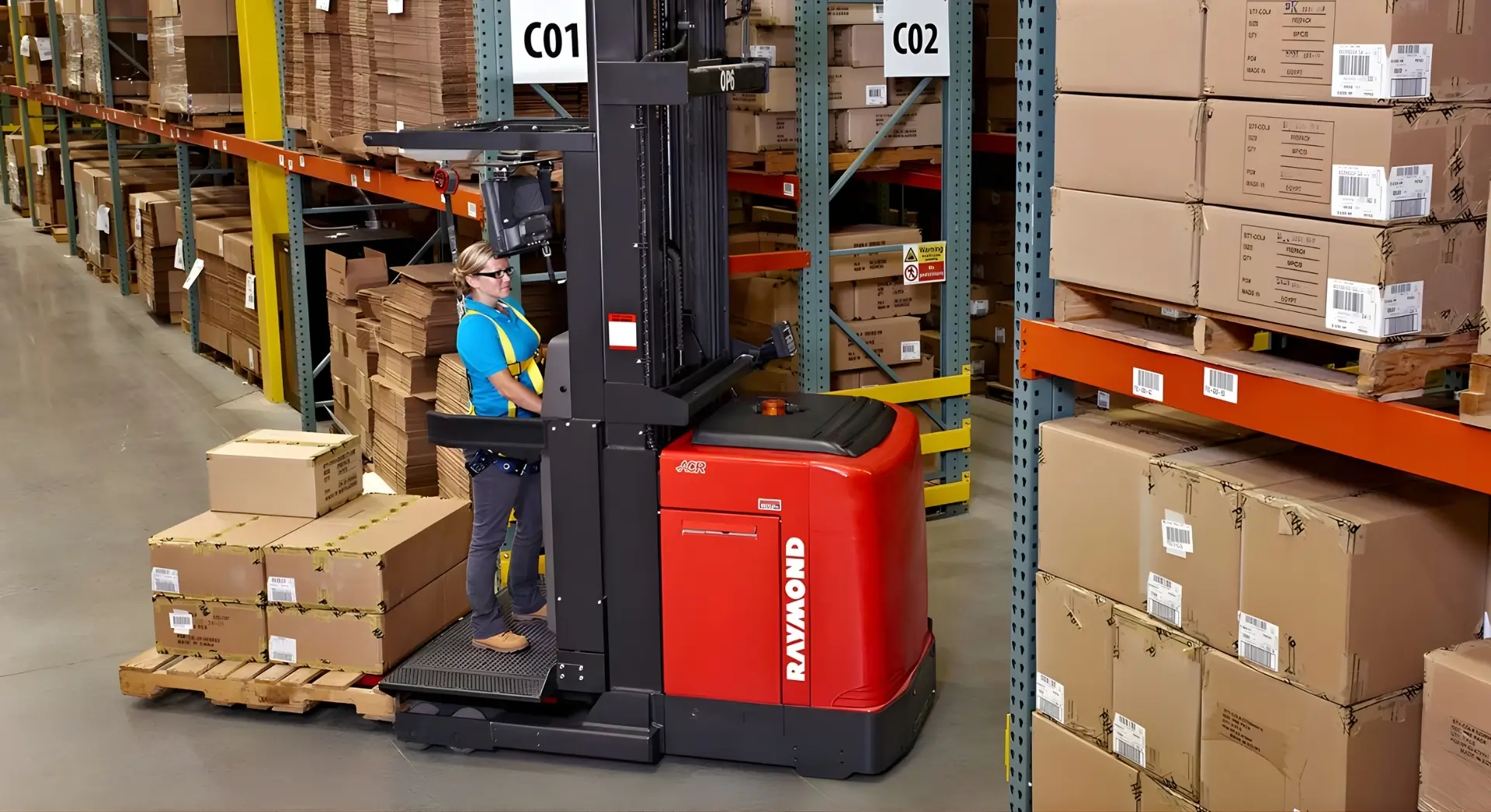
Order Pickers
Order pickers are designed to lift the operator rather than just the load. They are used in facilities where workers need direct access to individual items stored at various heights, such as e-commerce fulfillment centers and parts warehouses. With an integrated operator platform, these machines allow personnel to efficiently pick products from shelving without bringing entire pallets down.
Key Features
Order pickers focus on visibility, operator safety, and vertical mobility.
- Operator platform elevates along with the mast for direct access to stored items.
- Equipped with safety rails, harness points, and clear operator visibility zones.
- Lift heights commonly range from 20 to 30 feet or more.
- Typically include small storage or pallet platforms to collect picked items.
- Electric-powered for smooth operation and indoor use.
Common Uses
Order pickers excel in environments where items are handled individually rather than on pallets.
- Essential for e-commerce fulfillment and high-volume picking operations.
- Used to pick individual boxes or items from mid- to high-level shelving.
- Helpful in parts warehouses, furniture stores, and multi-level pick module systems.
- Most effective in very narrow aisles with guided movement for safety.
Power Options
These machines rely on efficient electric power systems for elevation and travel.
- Powered exclusively by rechargeable industrial batteries.
- Support long indoor shifts with low noise and no emissions.
- Often compatible with fast-charging stations for continuous picking operations.
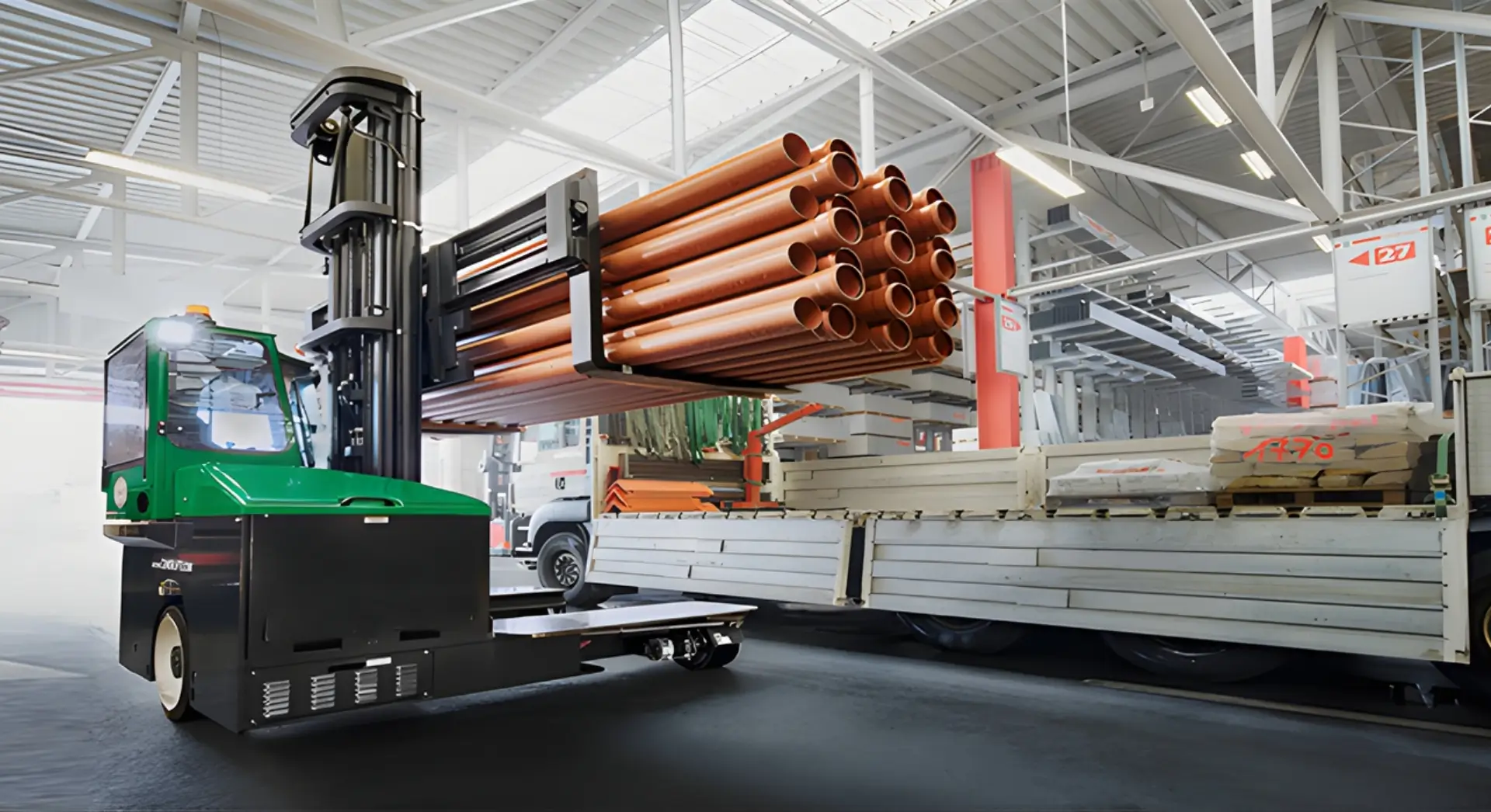
Side Loader Forklifts
Side loaders are engineered to transport long, bulky, or awkward loads that cannot be easily managed by standard forklifts. With forks mounted on the side of the machine and the load carried lengthwise along the truck’s frame, side loaders operate efficiently in narrow aisles while safely moving oversized materials like pipes, steel bars, or timber.
Key Features
Side loaders incorporate structural advantages for handling extra-long loads safely and efficiently.
- Side-mounted forks allow the operator to load and unload without turning the machine.
- Flatbed-style platform supports long or wide materials during travel.
- Multi-directional steering available on some models for enhanced sideways movement.
- High stability when transporting long loads compared to traditional forklifts.
- Available in electric or internal combustion configurations, depending on environment.
Common Uses
Industries that handle oversized or elongated materials benefit greatly from side loaders.
- Ideal for lumber yards, steel fabrication plants, and timber warehouses.
- Used for handling pipes, sheet metal, boards, and similar long materials.
- Effective in narrow aisles where turning a long load would be unsafe or impossible.
- Frequently used for outdoor and indoor cross-aisle transport of long goods.
Power Options
Side loaders come in multiple power formats for different working conditions.
- Electric models used primarily indoors for quiet, emissions-free operation.
- Diesel versions preferred for outdoor yards and long travel distances.
- Power selection depends on load size, operating surface, and indoor/outdoor requirements.
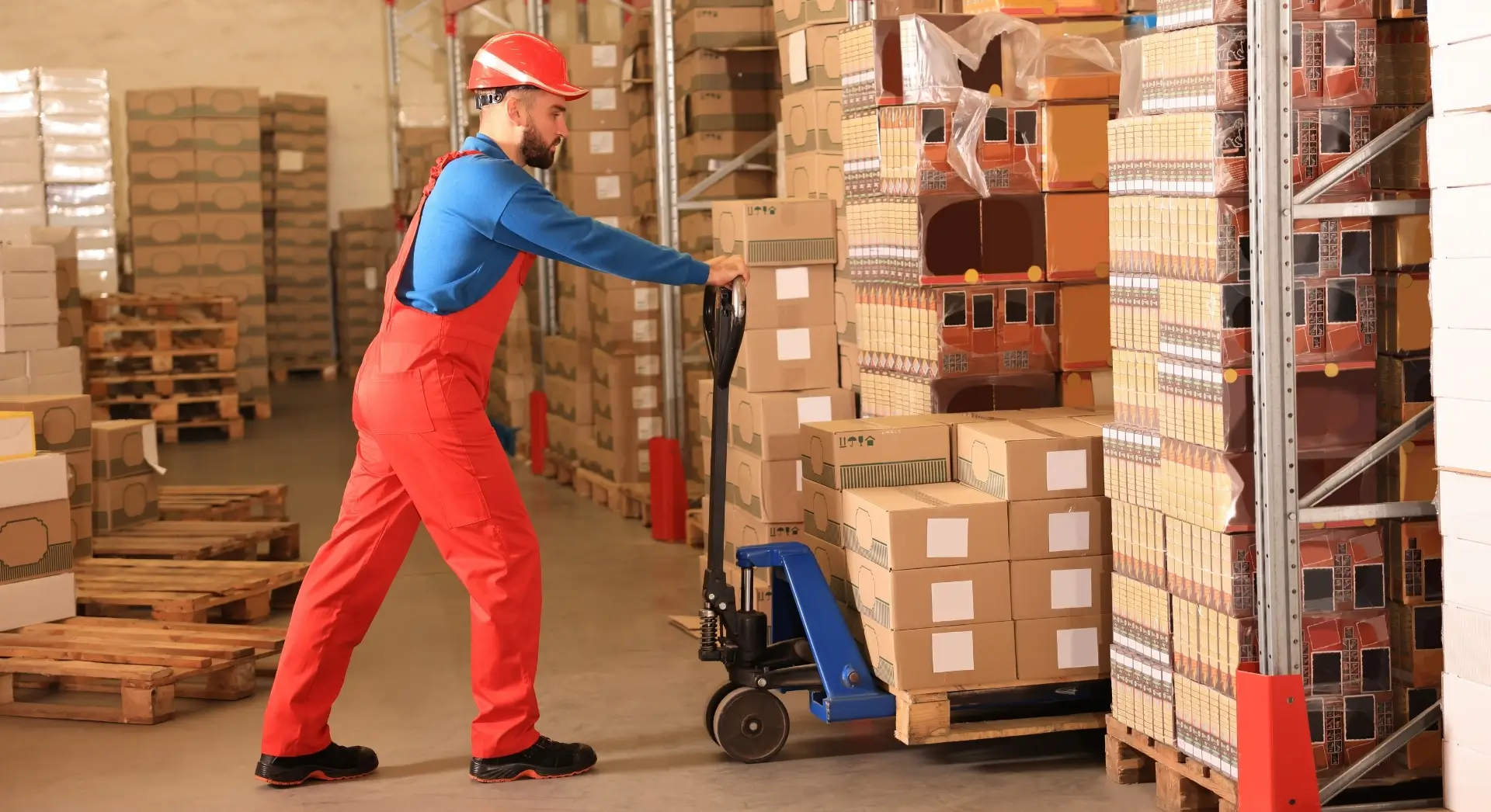
Pallet Jacks (Manual & Electric)
Pallet jacks, also called pump trucks, are the most basic pallet-moving tools used in material handling. They are built for simple, ground-level transportation of palletized goods and are commonly used in warehouses, retail shops, and delivery trucks. Their small size and low cost make them essential for short-distance material movement.
Key Features
Pallet jacks offer simplicity, durability, and maneuverability for everyday tasks.
- Minimal design with a handle, hydraulic lift mechanism, and two forks.
- Manual versions require physical pumping to raise the pallet slightly off the ground.
- Electric versions include a powered drive and lift mechanism to reduce operator effort.
- Compact footprint allows movement in tight spaces like truck trailers and store aisles.
- Low lift height—only a few inches—suitable for horizontal transport only.
Common Uses
Pallet jacks are widely used for quick, simple moves.
- Moving pallets short distances on smooth indoor surfaces.
- Unloading trucks where forklifts are unavailable or unnecessary.
- Stockroom and retail backroom operations.
- Ideal for small businesses or warehouses with light material-handling needs.
Power Options
Pallet jacks come in simple manual versions and more advanced electric setups.
- Manual pallet jacks operated by hand with no power source needed.
- Electric pallet jacks powered by rechargeable onboard batteries.
- Electric units provide easier movement for heavier pallets and frequent use.
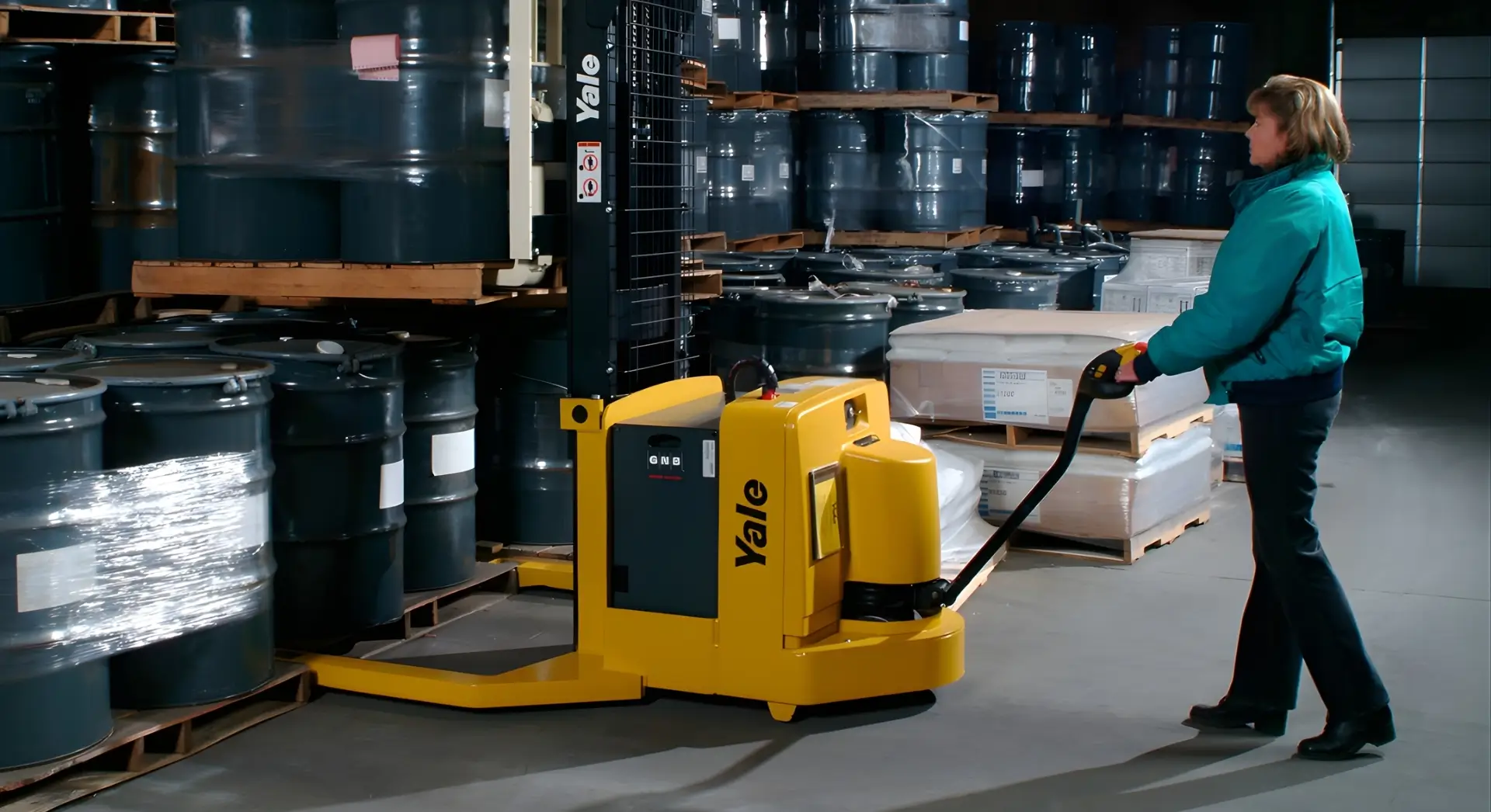
Walkie Stackers
Walkie stackers are compact, walk-behind lifting machines used for stacking pallets at moderate heights. They fill the gap between pallet jacks and full-sized forklifts by allowing operators to raise loads vertically while maintaining a small footprint. These are ideal for businesses that need vertical lifting but do not require a large forklift.
Key Features
Walkie stackers are built for practicality, affordability, and tight-area operation.
- Operated from behind using a tiller-style handle.
- Equipped with a mast capable of lifting pallets to mid-level racking.
- Straddle legs improve stability when lifting without the need for a heavy counterweight.
- Electric-powered for smooth, quiet indoor use.
- More compact and affordable compared to ride-on forklifts.
Common Uses
Walkie stackers are effective in environments that need affordable vertical lifting.
- Stacking pallets in small warehouses or stockrooms.
- Loading small trucks or platforms without a dock.
- Handling lighter loads in confined areas not accessible to larger forklifts.
- Ideal for occasional or moderate stacking needs.
Power Options
Walkie stackers operate using clean electric power systems.
- Powered exclusively by rechargeable batteries.
- Designed for indoor use with low maintenance requirements.
- Charging options range from built-in chargers to battery swap systems.
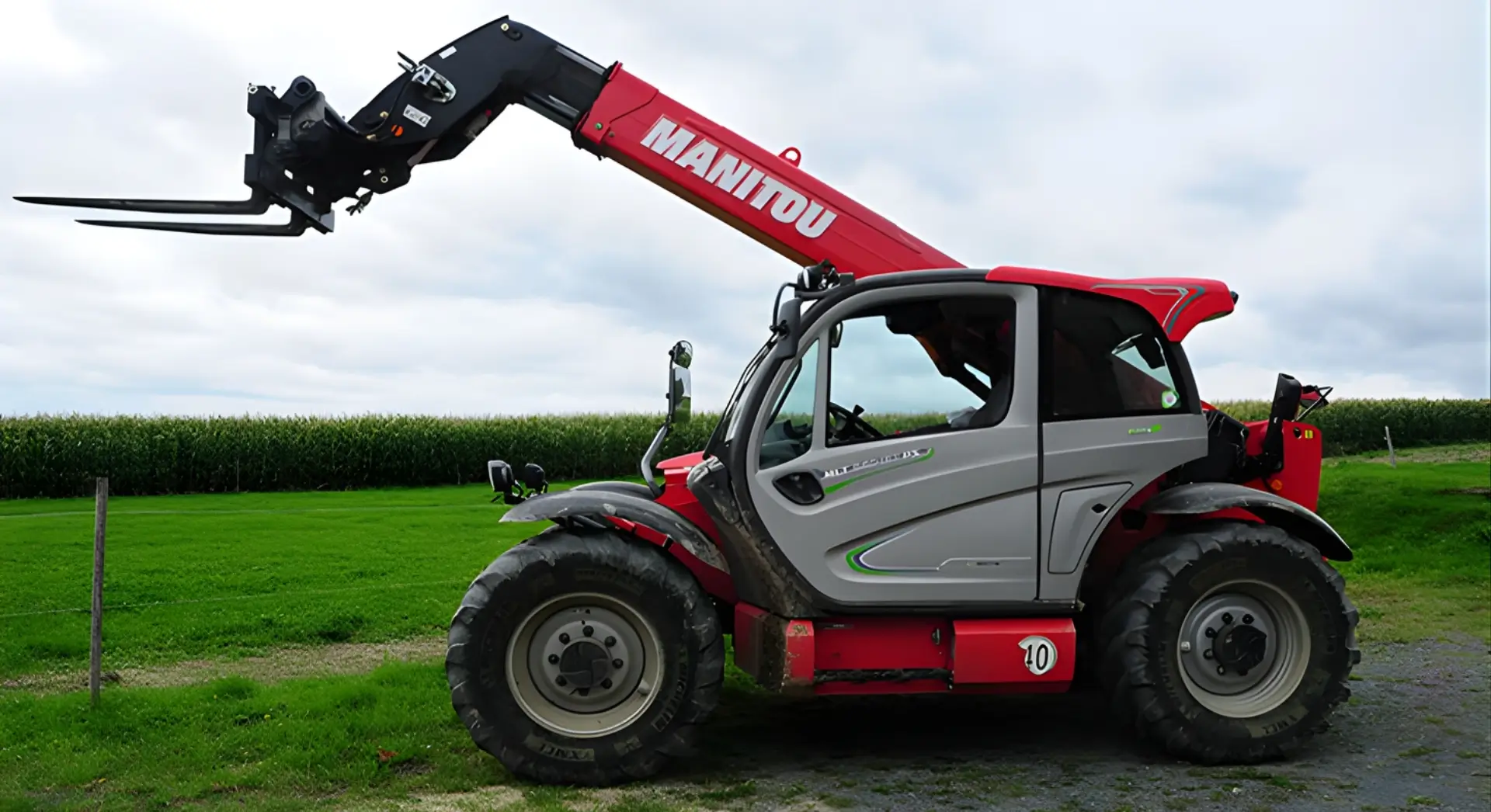
Telehandlers (Telescopic Handlers)
Telehandlers, also known as telescopic handlers or boom forklifts, are highly versatile lifting machines that combine the capabilities of a forklift and a crane. Their extendable telescopic boom allows operators to lift loads to great heights and reach forward into areas that standard forklifts can’t access. This makes them especially valuable on construction sites, farms, and industrial yards where height, reach, and rough terrain performance are essential.
Key Features
Telehandlers are built for height, reach, and rugged performance.
- Telescopic boom allows vertical and forward reach, extending over obstacles.
- Capable of lifting and placing loads at much greater heights than standard mast forklifts.
- Compatible with multiple attachments, including pallet forks, buckets, and lifting jibs.
- Large pneumatic tires and high ground clearance for outdoor and rough terrain use.
- Enclosed operator cab for safety and comfort in demanding environments.
Common Uses
Telehandlers excel in heavy, high-reach, and multi-purpose applications.
- Lifting and placing materials on upper floors or roofs at construction sites.
- Transporting loads across uneven terrain or long outdoor distances.
- Handling agricultural tasks such as moving hay bales or feed bags.
- Loading or unloading materials from elevated work zones or trucks.
- Reaching areas obstructed by trenches, debris, or barriers.
Power Options
Telehandlers are designed for outdoor strength and endurance.
- Primarily powered by diesel engines for high torque and continuous outdoor use.
- Some compact electric models exist for indoor or hybrid environments.
- Power selection depends on lifting height, load weight, and terrain requirements.

Rough Terrain Forklifts (Straight Mast Forklifts)
Rough terrain forklifts are engineered to operate on unpaved, uneven, and rugged surfaces. Unlike telehandlers, they use a traditional vertical mast combined with oversized pneumatic tires and heavy-duty construction. They are ideal for handling loads in outdoor environments where traction, stability, and ground clearance are critical.
Key Features
These forklifts are built to withstand challenging outdoor conditions.
- Large, deep-tread pneumatic tires designed for dirt, gravel, and uneven surfaces.
- Strong, reinforced mast and heavy-duty chassis for extra durability.
- High ground clearance to navigate obstacles and rough terrain safely.
- Typically four-wheel drive for improved traction and stability.
- Powerful engines for lifting heavy loads in off-road environments.
Common Uses
Rough terrain forklifts provide reliable lifting power across outdoor industries.
- Transporting building materials at construction sites.
- Handling lumber or logs in outdoor lumber and timber operations.
- Moving heavy supplies across farms, mines, and industrial yards.
- Loading or unloading trucks in outdoor locations without paved surfaces.
- Supporting emergency or disaster relief missions where terrain is unpredictable.
Power Options
Most rough terrain forklifts require strong outdoor performance.
- Diesel-powered engines are most common for maximum torque and durability.
- Some propane models exist for less demanding outdoor environments.
- Power choice depends on the type of load and working conditions.
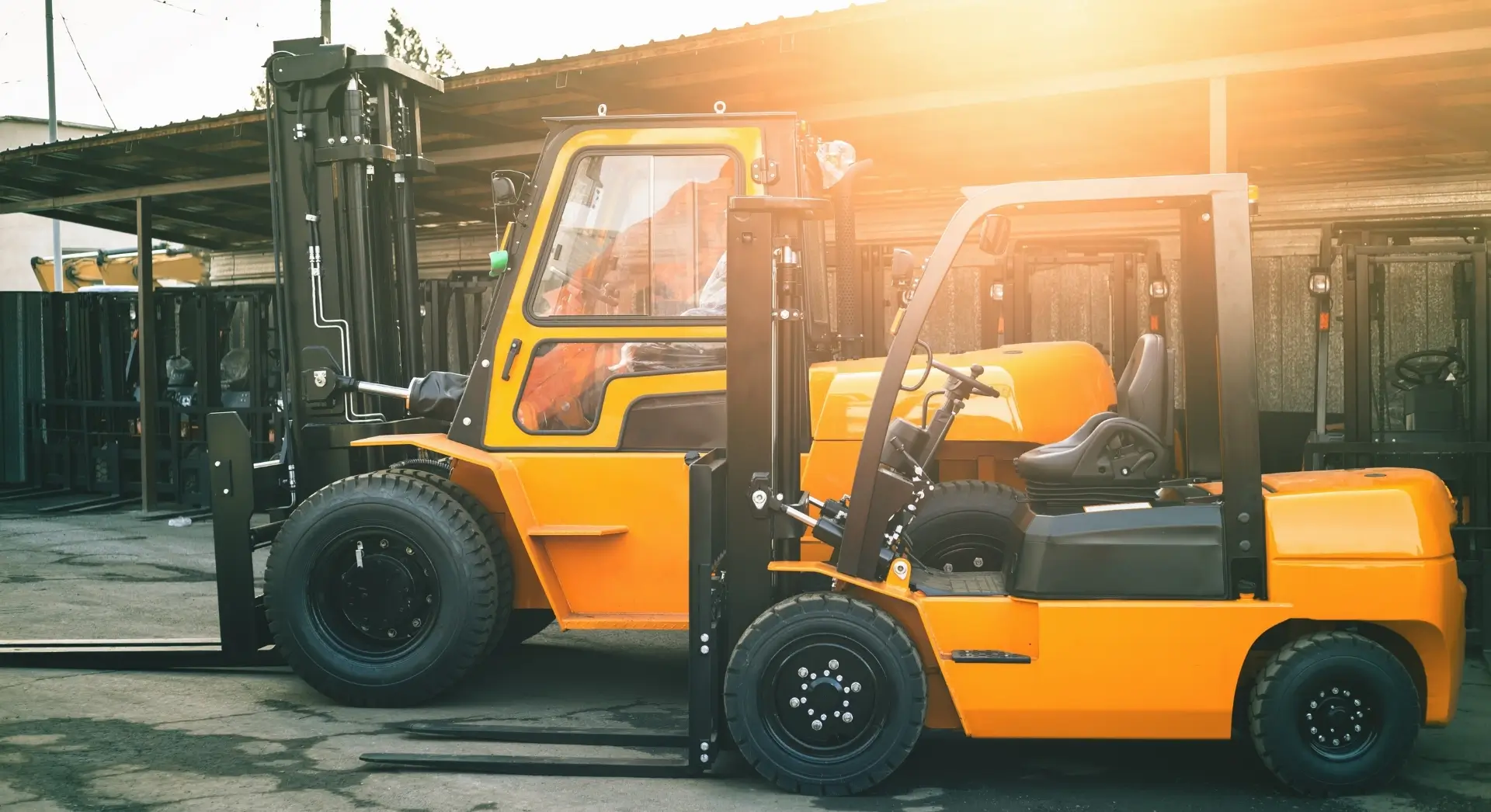
Heavy-Duty (High-Capacity) Forklifts
Heavy-duty forklifts are large, high-capacity machines designed to lift exceptionally heavy loads far beyond the capabilities of standard forklifts. They are commonly used in industries such as shipping, steel manufacturing, ports, and heavy fabrication. These massive forklifts offer extraordinary lifting power, structural reinforcement, and advanced stability systems for oversized materials.
Key Features
High-capacity forklifts are built for extreme industrial lifting.
- Load capacities ranging from 15,000 lbs to well over 100,000 lbs.
- Extremely durable frames, masts, and hydraulic systems.
- Larger counterweights and extended chassis for stability under heavy loads.
- Ability to support specialized attachments such as container handlers or coil rams.
- Designed for outdoor yards, ports, and heavy fabrication sites.
Common Uses
These forklifts are essential in operations where standard equipment is insufficient.
- Handling fully loaded shipping containers at ports or rail yards.
- Moving oversized steel components, coils, plates, or machinery.
- Supporting heavy industrial manufacturing processes.
- Loading and unloading large construction materials such as precast concrete.
- Transporting bulky, high-mass loads across wide outdoor facilities.
Power Options
High-capacity forklifts require powerful, durable engines.
- Primarily diesel-powered for maximum strength and endurance.
- Some hybrid or electric heavy-duty models exist but are less common.
- Power selection depends on load size, duty cycle, and industry requirements.
Choosing the Right Forklift for Your Needs
Selecting the appropriate forklift type is crucial for safety, efficiency, and cost-effectiveness. With many options available, consider the following factors when choosing a forklift for your business or project:
- Load Weight & Size: Determine the heaviest and bulkiest load you need to handle. Ensure the forklift’s capacity comfortably exceeds this. Standard forklifts handle ~5,000 lbs, while heavy-duty models can lift tens of thousands of pounds. Oversized materials (long lumber, shipping containers) may dictate specialized equipment (side loader, container handler).
- Lifting Height: How high do you need to lift? For stacking pallets on high racks, a reach truck or order picker may be necessary if heights exceed what a standard forklift can do. Telehandlers offer height and forward reach combined, which might be needed for certain outdoor jobs.
- Operating Environment: Indoor vs. Outdoor. For indoor warehouses with smooth floors and narrow aisles, electric warehouse forklifts, reach trucks, or walkie stackers are ideal (no emissions and tight turning). Outdoors on rough ground, rough terrain forklifts or telehandlers are designed for stability. If both indoor and outdoor use is needed, consider dual-fuel or pneumatic-tire models (Class V forklifts) that can handle moderate outdoor conditions.
- Space Constraints: Evaluate aisle widths and turning space in your facility. Very narrow aisles will require specialized narrow-aisle trucks (reach trucks or order pickers). Small storerooms might only accommodate pallet jacks or walkie stackers. Remember that counterbalance forklifts need more room to turn and maneuver compared to articulated or side-loading designs.
- Fuel Type and Power: Electric vs. Internal Combustion. Electric forklifts are quiet and emission-free – better for indoor air quality and usually lower maintenance per hour of use. They require battery charging infrastructure. Gas, diesel, or propane forklifts deliver higher power and often faster lifting speeds, and they can be refueled quickly for continuous use, making them suited for heavy-duty outdoor tasks. Also consider fuel cost and availability (propane is common for indoor/outdoor dual use in the US, diesel for large outdoor lifts).
- Specific Task Requirements: Think about any special tasks or attachments needed. For example, if you need to lift personnel for inventory picking, an order picker or a forklift with a safety man-basket attachment is necessary. If handling unusual loads like coils, drums, or oversized pallets, ensure the forklift can be fitted with the right attachments (clamps, rotators, etc.) and has the stability for those loads.
- Regulations and Training: Ensure that operators are trained and certified for the class of forklift they will use. In many jurisdictions (e.g., OSHA in the US), forklifts are categorized into Classes 1–7 based on fuel type and design, and operators must be specifically trained for each class. Safety should be a top priority – features like speed governors, lights, alarms, and fall-protection (for order pickers) might influence your choice.
By weighing all these factors, you can narrow down the forklift type that best matches your operational needs. Often, businesses may use a combination of forklift types – for instance, standard counterbalance forklifts for loading trucks, reach trucks for warehouse aisles, and pallet jacks for quick moves at ground level. The right mix will improve efficiency and reduce the risk of accidents or product damage.
Conclusion
Understanding the different types of forklifts empowers you to make smarter decisions when purchasing or renting equipment. Each forklift type – from the ubiquitous warehouse forklift to the specialized telehandler – has its strengths and ideal applications. By choosing a machine suited to your load size, height requirements, and work environment, you ensure safe and productive material handling for your business. Always remember to operate forklifts with trained personnel and adhere to safety guidelines for the best results. With the insights from this guide, warehouse managers and business owners can confidently identify which forklift types will keep their operations running smoothly.




